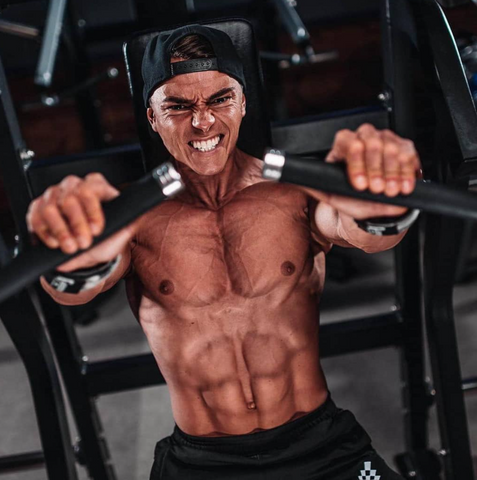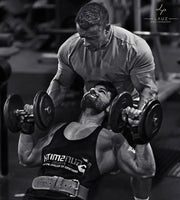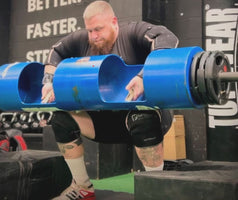How Much Should You Bench Press?
How much should I be able to bench press: A comprehensive guide
“How much ya bench”, “whaddaya bench?” These phrases have been heard in gyms since the dawn of time. The bench press is often hailed as the daddy of weight training exercises – and a lot of people like to think of it as the “great leveller”. Strip away everything else, and pound for pound, just how strong are you?

Just how much you bench depends on a lot of factors – your natural physical prowess or where you are in your fitness journey may be among many things to consider – but so you have a good idea of where you’re at, let’s talk in general. First up, let's go over your goals.
Determining Your Bench Press Goals
Setting Personal Goals
Before embarking on your bench press journey, it's essential to set personal goals. These goals should be realistic, achievable, and tailored to your individual preferences, lifestyle, and fitness level. Taking into account your experience with strength training and eventual targets like improving athletic performance, bodybuilding or powerlifting, choose a program that suits your specific needs.
Fitness Level and Experience
Your fitness level and experience will greatly impact your bench press performance. Typically, lifters are categorized as follows:
- Beginner: Usually little or no experience with strength training
- Novice: Some experience with simple strength training exercises
- Intermediate: Has a solid foundation in strength training and bench press
- Elite: Experienced athletes, competitive powerlifters, or bodybuilders
Bench press standards vary depending on experience:
| Fitness Level | Men | Women |
|---|---|---|
| Beginner | Body weight (0.5-0.7 times) | Body weight (0.3-0.4 times) |
| Novice | Body weight (0.8-1 times) | Body weight (0.5-0.6 times) |
| Intermediate | Body weight (1.2-1.5 times) | Body weight (0.7-0.8 times) |
| Elite | Body weight (1.9-2.2 times) | Body weight (1.0-1.3 times) |
*These figures represent the estimated one-rep max (1RM) bench press, which is based on body weight.
Age and Gender Factors
Bench press capacities differ significantly between age groups and genders. For the average adult male we are looking at the following:
- 1 x your own bodyweight: not bad, not bad at all my man
- 1.25 x your own bodyweight: now we're talking
- 1.5 x your own bodyweight: excellent work bro!
For women, the numbers generally are 0.65, 0.85, and 1 x your own bodyweight.
That’s the general gym consensus.
To delve a little bit more into things, your age, size, build, and fitness level (or lifting experience) needs to be looked at. For example, the average man, in ordinary circumstances, should be able to bench press 90% of his body weight. If you’re relatively fit and already going to the gym, then 1 x your bodyweight should be a good standard. In contrast, someone with an advanced fitness level or is an elite athlete should be able to lift more than twice their own bodyweight.
- A 220lbs man in his 20s would be able to lift 225 in an intermediate level, 305 in advanced, and 380 in elite.
- Men tend to be strongest in their 20s and 30s, and gradually decline as they get older.
- So, a man in his 20s, in an intermediate level, would be able to lift 100% of his body weight.
- A man in his 30s, in an intermediate level, would be able to lift 90% of his body weight.
- In his 40s, 80% of his body weight – and so on, though of course there would be exceptions.
Age and gender play a crucial role in determining the appropriate benchmarks, progression, and program variations. Keeping these factors in mind when setting your goals ensures that your approach is practical, achievable, and geared toward your demographic.
Setting bench press goals requires considering your personal objectives, fitness level, and both age and gender. Developing a suitable, progressive program aligned with your needs will lead to better results and continuous improvement in bench press performance.
What if I'm under those numbers?
Don't worry to much, remember to build gradually – no one walks into a gym for the first time looking like they could win body building contests (unless you work in a very labor intensive field, and maybe not even then). Constantly comparing yourself and your progress to what you see around you is a recipe for frustration. Instead, focus on yourself, and listen to your body. Get comfortable with what you can currently bench and gradually build on it, and make sure you’re taking care of all your other core muscles too so you avoid injury when you take on heavier and heavier loads.
Having the right diet can fast track your fitness journey, so eat healthy and focus on foods that build lean muscle – and stay hydrated, because you’ll be sweating a lot! Next up, the important stuff, technique.
Proper Bench Press Technique
Grip and Form
The key to a successful bench press session is maintaining proper form. To begin, lie down on a weight bench and position yourself so the barbell is directly over your chest. Position your hands shoulder-width apart on the barbell, and ensure your palms are facing outward. Retract your shoulder blades and create a slight back arch while keeping your feet flat on the ground, creating a stable and neutral spine.
Breathing and Stabilization
Breathing is an essential part of bench pressing as it promotes stabilization and ensures proper form. Inhale deeply before beginning the downward phase of the lift, and slowly lower the bar until it is close to your chest. When pressing the bar upwards, exhale forcefully, engaging your chest, triceps, and shoulders to complete the movement. As you exhale, remember to use leg drive by tightening your glutes and driving your legs into the ground. This technique allows for a more stable press and increased weight.
Incline and Decline Variations
In addition to the standard bench press, there are two popular variations: the incline and decline bench press. These variations target different areas of the chest, promoting balanced muscle growth and development.
- Incline bench press: Set the bench at a 45-degree angle. Perform the press with the same grip and form as the standard bench press. This variation places greater emphasis on the upper chest and shoulders, promoting hypertrophy in these areas.
- Decline bench press: Adjust the bench to a slight decline. Maintain proper grip and form from the standard bench press. The decline bench press targets the lower chest and can help reduce stress on the shoulders, thus minimizing the risk of injury.
By incorporating these variations into your bench press routine, you can ensure balanced muscle growth and development while minimizing the risk of injury due to improper form.

Designing a Bench Press Program
Volume, Sets, and Repetitions
To design an effective bench press program, one must consider volume, sets, and repetitions. As a general guideline, performing 3-5 sets of 5-8 repetitions per exercise is a good starting point. It provides enough volume for muscle growth and strength gains while preventing overtraining and allowing adequate recovery. For example:
- Week 1: 4 sets of 8 reps with a moderate load
- Week 2: 5 sets of 5 reps with a heavier load
Remember to tailor the number of sets and repetitions according to your specific goals, fitness level, and experience.
Importance of Progressive Overload
Progressive overload is the backbone of an effective training program. To make progress, it's crucial to gradually increase the amount of stress on the muscles during workouts. Bench press progress can be achieved by increasing weight, repetitions, or sets over time. For example, if you bench press 135 lb for 5 reps in week 1, aim for 140 lb in week 2. This ensures continuous progress and adaptation.
Bench Press Assistance Exercises
In addition to the bench press, incorporating assistance exercises can help target the chest, triceps, and shoulders, ultimately leading to a stronger bench press. Some popular assistance exercises include:
- Incline Dumbbell Bench Press: 3 sets of 10 reps
- Cable or Machine Fly: 3 sets of 12 reps
- Push-ups: 3 sets of max reps

To maximize the benefits of these exercises, try to maintain proper form and control throughout each repetition and ensure adequate rest between sets.
By considering volume, sets, and repetitions, progressively overloading the muscles, and incorporating assistance exercises, you can create a solid bench press program that's going to build a strong and powerful upper body.
Recommended Variations/Accessories for Bench Pressing
When looking to improve your bench press performance and technique, incorporating some specific accessories into your training can be beneficial. Here are a few essential accessories that can help enhance your bench press experience:
Close Grip Bench Press
The close grip bench press is an excellent variation to target the triceps and can improve the lockout portion of the lift. It is performed with a narrower grip compared to the regular bench press, which reduces the engagement of the pectoral muscles and increases the stress on the triceps.

Wide Grip Bench Press
In contrast to the close grip bench press, the wide grip bench press emphasizes the pectoral muscles, particularly the outer chest. It is performed with a grip wider than shoulder-width, which increases the range of motion and can help to improve your bench press strength.

Long Pause Bench Press
The long pause bench press involves holding the weight at the bottom position for an extended period (around 3-5 seconds) before pressing it back up. This technique helps to develop control and stability at the bottom of the lift and can improve your overall strength in the bench press.
Pin Press
The pin press is performed inside a power rack with safety pins set at a specific height to limit the range of motion. This allows you to target specific sticking points in the bench press and helps to improve your lockout strength.
Board Bench Press
This accessory exercise involves placing a wooden board or a similar rigid object on your chest while performing the bench press. By reducing the range of motion, the board bench press enables lifters to work on weak points and overload specific portions of the lift.
Incorporating these accessory exercises into your bench press routine can lead to significant improvements in strength, technique, and muscle development. Ensure that you perform them with proper form and progressively add weight to continue seeing results.

Bench Blaster Assisted Press
The Bench Blaster is a tool of varying resistance levels that allow a spring effect at the bottom of your lift off the chest. You simply slide your arms through the loops up to the biceps and you're good to go. It ensures perfect form, keeping the elbows tucked, the lats tight and the shoulders in a good position. The Bench Blaster allows you to safely overload (lift more weight) due to the spring effect. Most users see 10-20% increase in weight and smash their 1 rep max.
Safety Considerations
When it comes to bench pressing, safety should always be a top priority. You don't want to end up on a Tiktok video where you're getting crushed or weights are sliding off. You REALLY don't want this. Let's talk about the importance of lifting with a spotter and using safety racks to ensure a safe and effective workout session.
Lifting with a Spotter
Having a spotter while bench pressing is crucial for several reasons:
- A spotter can assist you in lifting the barbell off the rack and help you maintain proper form throughout the exercise.
- If you struggle during a lift, your spotter can provide immediate assistance, preventing injury from the barbell dropping onto your chest or neck.
- Spotters can also provide essential feedback on your technique, allowing you to make adjustments and improve your overall performance.
To effectively utilize a spotter, be sure to:
- Communicate clearly about your planned number of repetitions and the weight you are lifting.
- Ensure the spotter is aware of their role in assisting with lifting and providing support when needed. Make sure they aren't messing around on their phone whilst you're mid lift!
- Make certain the spotter is adequately positioned and capable of handling the weight you are lifting.

Using Safety Racks
Safety racks, also known as power racks or squat racks, are an essential piece of equipment for any bench press setup. These racks serve a dual purpose: to hold the barbell when not in use and to provide crucial safety features during the exercise. Let's look at the benefits:
- Adjustable safety pins or bars that can be set to catch the barbell if you are unable to complete a lift. This feature prevents the barbell from falling onto your chest or neck, reducing the risk of injury.
- The ability to perform a self-spot by appropriately placing the safety pins, enabling you to perform the bench press safely even when a spotter may not be available.
When using a safety rack, it's important to:
- Adjust the height of the safety pins or bars to an appropriate level for your individual size and workout plan.
- Ensure the rack is secure and stable before starting your bench press exercise.
- Perform a proper warm-up and follow a progressive lifting plan to minimize the risk of injury during your workout.
To summarise, having a safety rack and a spotter can give some peace of mind when trying to shift those big weights.
Lifting Accessories
Wrist wraps are a great addition to your kit. When bench pressing your wrists can be hit with a lot of strain so by wrapping up you're limiting hyperextending, you're also promoting the proper placement under the bar. Wrist wraps come in varying lengths and strengths so you can determine how tight you want your wrap to be.
Another solid item in your toolbox is the Elbow Sleeve. They offer more stability and compression for your elbow joints whilst performing the lift. By keeping your elbows warm you're also assisting your connective tissue warm up more efficiently.
Additional Factors Affecting Bench Press Performance
Comparing to Other Lifts
When assessing bench press performance, it's helpful to compare it to other main lifts, such as the squat and deadlift. These three exercises are often used as benchmarks for overall strength and muscle development. Typically, an individual's bench press strength is expected to be lower than their squat and deadlift numbers, due to the upper body's smaller muscle groups (chest, shoulders) being engaged in contrast to the larger ones in the lower body (back, legs) during squats and deadlifts. Check out our other articles for a squat info and what's a good leg press weight.
Nutrition and Recovery
Nutrition and recovery play a vital role in an individual's ability to improve their bench press performance. To achieve optimal muscle growth and strength gains, it's important to:
- Consume a balanced diet, rich in protein, to support muscle repair and growth
- Provide enough calories for energy and recovery
- Prioritize rest, getting adequate sleep and allowing enough time between training sessions for the body to recover
Developing and maintaining lean muscle mass will also have a positive impact on bench press performance.
Summary
That's the Bench Press covered! Check out our articles on Squatting and Deadlifting.







